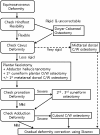Application of the Ilizarov technique to the correction of neurologic equinocavovarus foot deformity
- PMID: 20694536
- PMCID: PMC3032860
- DOI: 10.1007/s11999-010-1497-z
Application of the Ilizarov technique to the correction of neurologic equinocavovarus foot deformity
Abstract
Background: The treatment of rigid equinocavovarus foot deformities caused by neurologic disorders is often difficult and relapse is common.
Questions/purposes: We asked whether the Ilizarov technique could be used for correction of neurologic equinocavovarus foot deformities resulting in improved foot and ankle function and patient satisfaction.
Patients and methods: The neurologic equinocavovarus foot deformities of 26 patients (mean age, 18.7 years; 29 feet) were treated using the Ilizarov technique. Nine feet were treated by distraction histiogenesis only with limited soft tissue release, whereas 20 feet needed additional osteotomy and/or tendon transfer/lengthening. Minimum followup was 12 months (mean, 72.9 months; range, 12-155 months).
Results: The mean time required for deformity correction was 27.1 days (range, 14-47 days) and the mean time for stabilization in the apparatus was 23.2 days (range, 7-53 days). A painless, stable, and plantigrade result was obtained by 22 patients (24 feet). Mild residual foot deformity was observed in the remaining five feet of four patients. Six patients (six feet) experienced postoperative complications. Three patients (four feet) experienced recurrence of the deformity requiring surgical correction.
Conclusions: Ilizarov soft tissue distraction with or without callotasis of tarsal bone(s) allows a greater degree of correction of neurologic equinocavovarus foot deformities. However, to reduce the risk of recurrence after fixator removal, it may be necessary to overcorrect the deformity while in the fixator, to use nighttime splinting, and most importantly, to eliminate neuromuscular imbalance, if necessary, by combining arthrodesis with or without tendon transfer.
Level of evidence: Level IV, therapeutic study. See Guidelines for Authors for a complete description of levels of evidence.
Figures




Similar articles
-
Management of Neurologic Deformity of the Ankle and Foot With Concurrent Osteomyelitis With the Ilizarov Method.Foot Ankle Int. 2018 Feb;39(2):226-235. doi: 10.1177/1071100717739396. Epub 2017 Nov 21. Foot Ankle Int. 2018. PMID: 29160725
-
Correction of complex foot deformities using the Ilizarov external fixator.J Foot Ankle Surg. 2002 Jan-Feb;41(1):30-9. doi: 10.1016/s1067-2516(02)80007-2. J Foot Ankle Surg. 2002. PMID: 11858604
-
Use of Ilizarov External Fixation Without Soft Tissue Release to Correct Severe, Rigid Equinus Deformity.J Foot Ankle Surg. 2015 Sep-Oct;54(5):821-5. doi: 10.1053/j.jfas.2014.12.039. Epub 2015 May 23. J Foot Ankle Surg. 2015. PMID: 26015298
-
Operative treatment of the difficult stage 2 adult acquired flatfoot deformity.Foot Ankle Clin. 2001 Mar;6(1):95-119. doi: 10.1016/s1083-7515(03)00083-4. Foot Ankle Clin. 2001. PMID: 11385931 Review.
-
Correction of severe residual clubfoot deformity in adolescents with the Ilizarov technique.Foot Ankle Clin. 2004 Sep;9(3):571-82, ix. doi: 10.1016/j.fcl.2004.05.011. Foot Ankle Clin. 2004. PMID: 15324791 Review.
Cited by
-
Narrative review of ring fixator management of recurrent club foot deformity.Ann Transl Med. 2021 Jul;9(13):1104. doi: 10.21037/atm-20-7621. Ann Transl Med. 2021. PMID: 34423016 Free PMC article. Review.
-
Reconstruction of First Metatarsal Bone Loss Following Osteomyelitis by a Modified Masquelet Technique: A Case Report.J Orthop Case Rep. 2020 Dec;10(9):118-120. doi: 10.13107/jocr.2020.v10.i09.1930. J Orthop Case Rep. 2020. PMID: 34169032 Free PMC article.
-
Tibial Cortex Transverse Distraction Followed by Open Correction with Internal Fixation for Management of Foot and Ankle Deformity with Ulcers.Orthop Surg. 2021 Oct;13(7):2081-2092. doi: 10.1111/os.13148. Epub 2021 Oct 1. Orthop Surg. 2021. PMID: 34596962 Free PMC article.
-
[Ilizarov technique combined with limited surgery for correction of spastic clubfoot in adolescents with cerebral palsy].Zhongguo Xiu Fu Chong Jian Wai Ke Za Zhi. 2018 Feb 15;32(2):182-186. doi: 10.7507/1002-1892.201710045. Zhongguo Xiu Fu Chong Jian Wai Ke Za Zhi. 2018. PMID: 29806409 Free PMC article. Chinese.
-
The epidemiological characteristics of neurogenic limb deformity disorder in China: a national-based study from Qin Sihe orthopedic center.BMC Public Health. 2023 Mar 27;23(1):567. doi: 10.1186/s12889-023-15470-9. BMC Public Health. 2023. PMID: 36973707 Free PMC article.
References
-
- Atar D, Lehman WB, Grant AD. Complications in clubfoot surgery. Orthop Rev. 1991;20:233–239. - PubMed
-
- Carroll NC. Controversies in the surgical management of clubfoot. Instr Course Lect. 1996;45:331–337. - PubMed
-
- Carroll NC, McMurtry R, Leete SF. The pathoanatomy of congenital clubfoot. Orthop Clin North Am. 1978;9:225–232. - PubMed
MeSH terms
LinkOut - more resources
Full Text Sources
Medical
Research Materials

